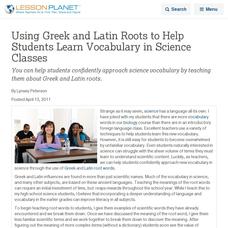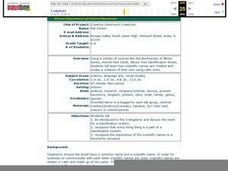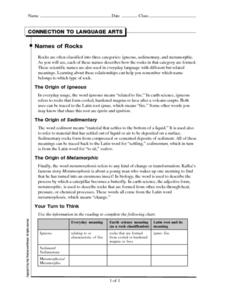Curated OER
Latin Lingo
Did you know that the Greek and Latin root words that make up the scientific name of a creature often describe the animal? All the root words on this list relate to whales and dolphins. Learners examine the scientific names for dolphins...
Curated OER
Using Greek and Latin Roots to Help Students Learn Vocabulary in Science Classes
You can help students confidently approach science vocabulary by teaching them about Greek and Latin roots.
Curated OER
Scientific Root Words, Prefixes, and Suffixes
It's hard to imagine that anything was missed on this five-page list of science roots, prefixes, and suffixes! Listed in alphabetical order, all are included in a single, two-column list. This may be especially useful for advanced...
Curated OER
Guided Reading Organizer for Chain Reaction
The class uses Chain Reaction, a magazine, to build a better understanding of Latin and Greek roots found in scientific vocabulary. They use two attached worksheets to help them read a scientific article, using visual clues and their...
Curated OER
Neuroscience Word Origins
In this neuroscience worksheet, students match neuroscience words with the illustration that represents the original meaning of the word in Greek or Latin. This worksheet has 10 matching questions.
Curated OER
Connection to Language Arts-The Structure of Medical Terminology
In this structure of medical terminology instructional activity, students read about Latin and Greek roots and match nine medical terms to their definitions using a table of defined prefixes, roots and suffixes.
Curated OER
Creative Classroom Creatures
Students are introduced to the five kingdoms and discover why there is a need for a classification system. Using the internet, they examine how scientific names are created and practice putting animals into their correct classification....
Curated OER
Connection to Language Arts-Hidden Meanings
In this etymology instructional activity, students read about the history of naming words and how words are named. They think critically by answering three questions about the meaning of words, etymologies and the derivation of words.
Curated OER
Life Science: Living Things
Have your class build their vocabulary bank by studying life science terms. Basic terms like organism, cell, unicellular, and vertebrate are included on the definition sheet provided. Demonstrate how to identify different life science...
Curated OER
The Language of Science
In this language of science activity, students use the list provided to guess the meaning of each of the list. Students apply root words, prefixes, and suffixes to gain meaning of other science words.
Curated OER
Animal Classification
Learners are introduced to the concept of classification as it relates to objects, information, and characteristics. In this classification lesson, students research a variety of animals. Learners study the Linnaeus's system of...
Curated OER
Linnaeus' Latin Lingo
Students use Latin and Greek words to figure out species names for whales.
Curated OER
What is in a Name?
Students examine taxonomy and the use of dichotomous keys through two activities. They use a dichotomous key and create one of their own as well as create new scientific Family names for penguins using same word roots used by taxonomists.
Curated OER
Defining the Difference Between Prokaryotic and Eukaryotic Cells
Students examine microscopic life by conducting a scientific investigation. In this cell analysis lesson, students define the prokaryotic and eukaryotic cells and discuss their word origins. Students view each type of cell on slides...
University of Wisconsin
Bimodel Botany Bouquet
Gardeners are given an individual plant specimen from a bouquet of local rain garden plants. They group up by their plant type and then make observations together, name the plant, and introduce it to the rest of the class. You then share...
Alabama Learning Exchange
Animal Classification
Present information about the classification of animals. After participating in the teacher-led discussion about scientific names, small groups devise their own way of classifying everyday objects present in the classroom, developing...
Alabama Learning Exchange
The Rockin' Rock Cycle: Metamorphic Rocks
Learners study the formation of metamorphic rock. In this metamorphic rock lesson, students examine how metamorphic rock forms as part of the rock cycle. They review the rock cycle using chocolate chips, conduct Internet research, and...
Curated OER
Bacteria Aren't All Bad!
Teaching students about the diversity of the Bacteria Kingdoms and their importance to humans
Alabama Learning Exchange
The Causes of Pollution
Learners identify types of pollution. For this environmental lesson, students view a video and discuss the types of pollution. Learners create a poster to suggest ways to prevent pollution.
Curated OER
Life's Lessons: Survival of the Fittest
Students analyze Jack London's use of anthropomorphism to identify the importance of adaptability in life. In this literature lesson, students use the novel The Call of the Wild to identify key elements in survival. Students...
Curated OER
Names of Rocks
In this types of rocks worksheet, students read about igneous rocks, sedimentary rocks and metamorphic rocks. They complete a chart about the three types of rocks and use the information from the reading to determine the origin of their...
Alabama Learning Exchange
Echolocation Stations: Exploring Sound
Fourth graders explore the concept of echolocation during a unit on whales. They listen to the book and watch the Reading Rainbow video for "Humphrey: The Wayward Whale," explore various websites, and conduct experiments to demonstrate...
Curated OER
Creature Feature
Students make detailed observations and identify an unknown using descriptions. For this observation lesson students are given a creature and must be able to identify it by species and genus.
Curated OER
After the Garbage Can: Where Does Our Trash Go?
Students explore how waste disposal has changed over time and what the current issues are. In this disposal lesson students collect data and create graphs.




















